 |
 |
||||||||||||
|
|||||||||||||
|
|
A guide dog at work, what the master thinksWhen you see a blind person with his guide dog it is hard to fathom the months of hard work and education that went into making them a team. Some breeds make better guide dogs than others, but not all the dogs of a particular breed become good guide dogs. The dog requires specific qualities and after his training he needs to be certified before he is handed over to his new master. Furthermore, the dog guiding someone who has impaired vision works differently from the one guiding a person who is completely blind. How well a dog guides his master depends on their teamwork. They must trust each other and be compatible, and over time their close bond will allow them to move around more freely. The blind person must always be in control, but the guide dog should take an initiative should his charge be in danger.
After using a cane for over 20 years I will try to explain to you how the guide dog has changed my life. When I use my cane only the ground exists. I would be in a vacuum without my ears and my brain. The acoustics (the reverberation of the sounds that my cane makes on the surfaces it touches) allow me to picture my surroundings so that I can orient myself in the space I am in. I can thus move along a wall and detect openings (a building entrance, an intersection). But, in order that the ears pick up these details, there should be no other noises interfering. So I need to be extremely concentrated when I move about with my cane. 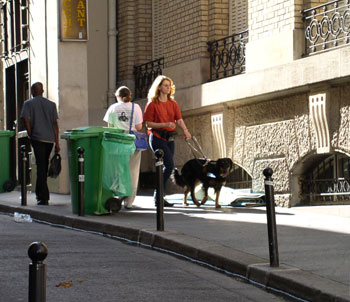 When I am out with my dog I also need to know where I am and where I am going. Patty obeys different commands (left, right, find the door, etc.) and avoids or warns me of any obstacles in our way. These may be on the ground (steps, holes, pipes across the path), immobile obstacles (posts, garbage cans, pot plants, bikes parked on the pavement) or mobile ones (pedestrians).
When I am out with my dog I also need to know where I am and where I am going. Patty obeys different commands (left, right, find the door, etc.) and avoids or warns me of any obstacles in our way. These may be on the ground (steps, holes, pipes across the path), immobile obstacles (posts, garbage cans, pot plants, bikes parked on the pavement) or mobile ones (pedestrians).
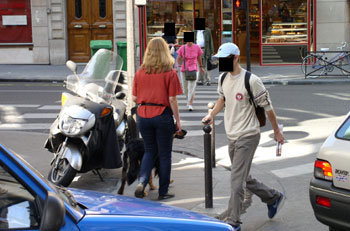 Because of my guide dog I am usually unaware of the kind of obstacle, if any, that is in our way. When I am out with my cane, however, I expect the environment to be hostile. There will be innumerable obstacles in my way: poles, flower pots, garbage cans, restaurant signs, etc. These all slow down my pace considerably.
The surface of the ground is also full of surprises. When it is rough or irregular I cannot make sweeping movements with my cane which then misses small objects which could cause me to stumble. Snow and dead leaves are also a bother. They not only hide objects underneath them but also change the acoustics, so I have difficulty orienting myself.
Because of my guide dog I am usually unaware of the kind of obstacle, if any, that is in our way. When I am out with my cane, however, I expect the environment to be hostile. There will be innumerable obstacles in my way: poles, flower pots, garbage cans, restaurant signs, etc. These all slow down my pace considerably.
The surface of the ground is also full of surprises. When it is rough or irregular I cannot make sweeping movements with my cane which then misses small objects which could cause me to stumble. Snow and dead leaves are also a bother. They not only hide objects underneath them but also change the acoustics, so I have difficulty orienting myself.
When there are many obstacles in a wide open space I lose my bearings and may move off course. I then have a hard time getting back to where I wanted to be. I don't know how often I have gotten lost at the Chatelet train station, a large terminal with many subway and regional train connections. By moving around a large group of travelers I will not notice that I have changed direction! 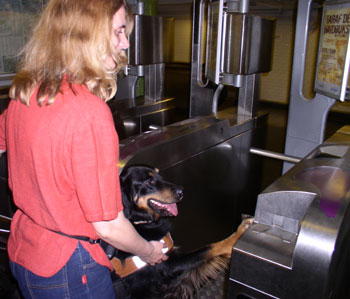 With Patty this never happens. She has memorized my route and takes me straight to the train I want to take. When she is with me I always arrive at my destination.
A dog is not bothered by peripheral noises (construction, street musicians, sirens, etc.) which are very bothersome when walking with a cane.
Also, other pedestrians are usually in a hurry and don't see my cane. So they trip over it and break it. I have had to replace it on numerous occasions and now always carry a spare one with me.
With Patty this never happens. She has memorized my route and takes me straight to the train I want to take. When she is with me I always arrive at my destination.
A dog is not bothered by peripheral noises (construction, street musicians, sirens, etc.) which are very bothersome when walking with a cane.
Also, other pedestrians are usually in a hurry and don't see my cane. So they trip over it and break it. I have had to replace it on numerous occasions and now always carry a spare one with me.
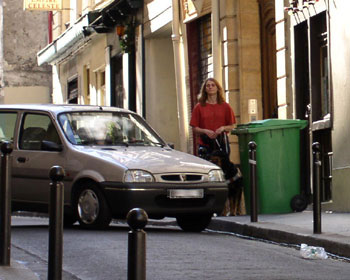 On a given route the dog has to calculate the space he and his master need to move around an obstacle. If it is on the pavement he has to decide whether we can move around it, and if so, on which side. If the space available is restricted he will slow down as he moves forward to assure that we can both pass.
On a given route the dog has to calculate the space he and his master need to move around an obstacle. If it is on the pavement he has to decide whether we can move around it, and if so, on which side. If the space available is restricted he will slow down as he moves forward to assure that we can both pass.
On the other hand, when walking with a cane, I have to do all this on my own. The dog has also learnt to avoid raised obstacles, e.g. traffic lights at face level, or barriers at chest level. He will not only judge whether he can pass under them but also whether I can. In comparison, the cane shows serious limitations in this case. If the cane hits an obstacle at a fair distance I have time to stop. But the higher the obstacle the shorter this distance will be. At under 1 meter the cane will not detect anything in time and I will hit it face on or with my body, e.g. a suspended sign or one attached to a pole; an open van door that reaches over the pavement. I cannot be absent-minded or daydream when walking with my cane. It needs my total concentration. 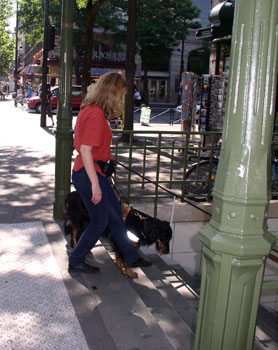 The dog has two roles: he needs to protect his master and get him to the desired destination. I never bother to look for the subway entrance any longer. All I say is "find the subway" and Patty leads me straight there. The same applies to bus stops, doors and stairways. The latter are differentiated as follows: "stairway" to ascend, "descend" for those that go down. I also don't need to tap the sidewalk to find a pedestrian crossing. All I say is "find the lines - ahead, on the right, on the left…".
The dog has two roles: he needs to protect his master and get him to the desired destination. I never bother to look for the subway entrance any longer. All I say is "find the subway" and Patty leads me straight there. The same applies to bus stops, doors and stairways. The latter are differentiated as follows: "stairway" to ascend, "descend" for those that go down. I also don't need to tap the sidewalk to find a pedestrian crossing. All I say is "find the lines - ahead, on the right, on the left…".
If I want to mail a letter I no longer feel my way along the wall for the mailbox. I tell Patty "find the letter" and she puts her paws on the letterbox. The same goes for the ticket machines, booths, etc. If I'm looking for a doorbell I say "find the button". To find a free seat I no longer need to ask someone. Patty brings me straight there and puts her head on it. These are some basic examples which can be modified to suit the individual needs. I now find myself daydreaming on the subway because Patty will automatically get up at the right station, provided she knows the way. You'd think she can read! 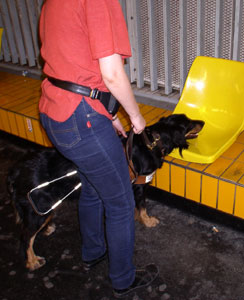
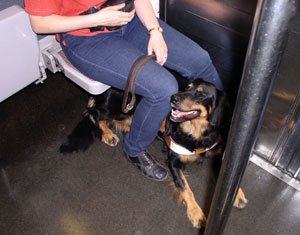
Ever since Patty goes out with me I feel less alone. I have become more self-assured and relaxed. I trust my dog. I know she will alert me when need be and if the situation requires it she will disobey me. I don't hesitate to go to unknown places or to change my route if my usual one is blocked. My itinerary has expanded immensely and I ask my way less and less often. My dog has become extremely precious to me. It is another world when I go out with her. I have become more autonomous and my relationship with the world has also changed. Thanks to Patty I am living a freer life. I feel I can fly! By Olivia and Patty
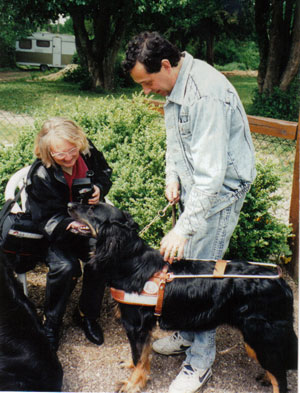 |
||||||||||||
|
|
|||||||||||||